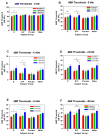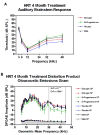Hormone replacement therapy diminishes hearing in peri-menopausal mice
- PMID: 19269311
- PMCID: PMC2698030
- DOI: 10.1016/j.heares.2009.02.010
Hormone replacement therapy diminishes hearing in peri-menopausal mice
Abstract
We recently discovered that progestin in hormone replacement therapy (HRT) for post-menopausal women has detrimental effects on the ear and central auditory system [Guimaraes, P., Frisina, S.T., Mapes, F., Tadros, S.F., Frisina, D.R., Frisina, R.D., 2006. Progestin negatively affects hearing in aged women. Proc. Natl. Acad. Sci. - PNAS 103, 14246-14249]. To start determining the generality and neural bases of these human findings, the present study examined the effects of combination HRT (estrogen+progestin) and estrogen alone on hearing in peri-menopausal mice. Specifically, auditory brainstem responses (ABRs-sensitivity of the auditory system) and distortion-product otoacoustic emissions (DPOAEs-cochlear outer hair cell system) were employed. Middle age female CBA mice received either a time-release, subcutaneous implanted pellet of estrogen+progestin, estrogen alone, or placebo. Longitudinal comparisons of ABR threshold data obtained at 4 months of treatment revealed statistically significant declines in auditory sensitivity over time for the combined estrogen+progestin treatment group, with the estrogen only group revealing milder changes at 3, 6 and 32 kHz. DPOAE testing revealed statistically significant differences for the estrogen+progestin treatment group in the high and middle frequency ranges (15-29 and 30-45 kHz) after as early as 2 months of treatment (p<0.01 and p<0.001, respectively). Statistically significant changes were also seen at 4 months of treatment across all frequencies for the combined HRT group. These data suggest that estrogen+progestin HRT therapy of 4 months duration impairs outer hair cell functioning and overall auditory sensitivity. These findings indicate that estrogen+progestin HRT may actually accelerate age-related hearing loss, relative to estrogen monotherapy; findings that are consistent with the clinical hearing loss observed in aging women that have taken combination HRT.
Figures



Similar articles
-
Sex differences in distortion product otoacoustic emissions as a function of age in CBA mice.Hear Res. 2004 Jun;192(1-2):83-9. doi: 10.1016/j.heares.2004.01.013. Hear Res. 2004. PMID: 15157966
-
Interactions of hearing loss and diabetes mellitus in the middle age CBA/CaJ mouse model of presbycusis.Hear Res. 2009 Mar;249(1-2):44-53. doi: 10.1016/j.heares.2009.01.007. Hear Res. 2009. PMID: 19271313 Free PMC article.
-
L-Ergothioneine slows the progression of age-related hearing loss in CBA/CaJ mice.Hear Res. 2024 May;446:109004. doi: 10.1016/j.heares.2024.109004. Epub 2024 Apr 2. Hear Res. 2024. PMID: 38608332 Free PMC article.
-
Genetic influences on susceptibility of the auditory system to aging and environmental factors.Scand Audiol Suppl. 1992;36:1-39. Scand Audiol Suppl. 1992. PMID: 1488615 Review.
-
Controversial issues in climacteric medicine II. Hormone replacement therapy and cancer. International Menopause Society Expert Workshop. 9-12 June 2001, Opera del Duomo, Pisa, Italy.Climacteric. 2001 Sep;4(3):181-93. Climacteric. 2001. PMID: 11588941 Review.
Cited by
-
Recent advances in the study of age-related hearing loss: a mini-review.Gerontology. 2012;58(6):490-6. doi: 10.1159/000338588. Epub 2012 Jun 15. Gerontology. 2012. PMID: 22710288 Free PMC article. Review.
-
Hormone replacement therapy attenuates hearing loss: Mechanisms involving estrogen and the IGF-1 pathway.Aging Cell. 2019 Jun;18(3):e12939. doi: 10.1111/acel.12939. Epub 2019 Mar 7. Aging Cell. 2019. PMID: 30845368 Free PMC article.
-
Sex differences and the effect of female sex hormones on auditory function: a systematic review.Front Hum Neurosci. 2023 Apr 21;17:1077409. doi: 10.3389/fnhum.2023.1077409. eCollection 2023. Front Hum Neurosci. 2023. PMID: 37151900 Free PMC article. Review.
-
Transcriptomic analysis of the developing and adult mouse cochlear sensory epithelia.PLoS One. 2012;7(8):e42987. doi: 10.1371/journal.pone.0042987. Epub 2012 Aug 10. PLoS One. 2012. PMID: 22900075 Free PMC article.
-
Translational implications of the interactions between hormones and age-related hearing loss.Hear Res. 2021 Mar 15;402:108093. doi: 10.1016/j.heares.2020.108093. Epub 2020 Oct 15. Hear Res. 2021. PMID: 33097316 Free PMC article. Review.
References
-
- Albertson BD, Bradley EL, Terman CR. Plasma progesterone concentration in prairie deermice (Peromyscus maniculatus bairdii) from experimental laboratory populations. J Reprod Fert. 1975;42:407–414. - PubMed
-
- Bittar RS, Cruz OL, Lorenzi MC, Marone SA, Miniti A. Morphological and functional study of the cochlea after administration of estrogen and progesterone in the guinea pig. Int Tinnitus J. 2001;7:41–5. - PubMed
-
- Caruso S, Maiolino L, Rugolo S, Intelisano G, Farina M, Cocuzza S, Serra A. Auditory brainstem response in premenopausal women taking oral contraceptives. Human Reproduction. 2003;18:85–89. - PubMed
-
- Coleman JR, Campbell D, Cooper WA, Welsh MG, Moyer J. Auditory brainstem responses after ovariectomy and estrogen replacement in rat. Hear Res. 1994;80:209–15. - PubMed
-
- Frisina RD, Rajan R. Inferior Colliculus: Aging and plasticity. In: Winer J, Schreiner C, editors. The Inferior Colliculus. New York: Springer; 2005. pp. 559–584. Ch. 18.
Publication types
MeSH terms
Substances
Grants and funding
LinkOut - more resources
Full Text Sources
Other Literature Sources

